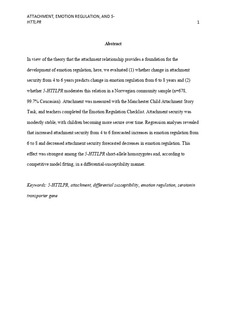| dc.contributor.author | Viddal, Kristine Rensvik | |
| dc.contributor.author | Berg-Nielsen, Turid Suzanne | |
| dc.contributor.author | Belsky, Jay | |
| dc.contributor.author | Wichstrøm, Lars | |
| dc.date.accessioned | 2019-11-14T07:35:40Z | |
| dc.date.available | 2019-11-14T07:35:40Z | |
| dc.date.created | 2017-03-24T15:36:24Z | |
| dc.date.issued | 2017 | |
| dc.identifier.citation | Developmental Psychology. 2017, 53 (7), 1316-1329. | nb_NO |
| dc.identifier.issn | 0012-1649 | |
| dc.identifier.uri | http://hdl.handle.net/11250/2628396 | |
| dc.description.abstract | In view of the theory that the attachment relationship provides a foundation for the development of emotion regulation, here, we evaluated (a) whether change in attachment security from 4 to 6 years predicts change in emotion regulation from 6 to 8 years and (b) whether 5-HTTLPR moderates this relation in a Norwegian community sample (n = 678, 99.7% Caucasian). Attachment was measured with the Manchester Child Attachment Story Task, and teachers completed the Emotion Regulation Checklist. Attachment security was modestly stable, with children becoming more secure over time. Regression analyses revealed that increased attachment security from 4 to 6 forecasted increases in emotion regulation from 6 to 8 and decreased attachment security forecasted decreases in emotion regulation. This effect was strongest among the 5-HTTLPR short-allele homozygotes and, according to competitive model fitting, in a differential-susceptibility manner. | nb_NO |
| dc.language.iso | eng | nb_NO |
| dc.publisher | American Psychological Association | nb_NO |
| dc.title | Change in Attachment Predicts Change in Emotion Regulation — Particularly among 5-HTTLPR Short-Allele Homozygotes | nb_NO |
| dc.type | Journal article | nb_NO |
| dc.type | Peer reviewed | nb_NO |
| dc.description.version | acceptedVersion | nb_NO |
| dc.source.pagenumber | 1316-1329 | nb_NO |
| dc.source.volume | 53 | nb_NO |
| dc.source.journal | Developmental Psychology | nb_NO |
| dc.source.issue | 7 | nb_NO |
| dc.identifier.doi | 10.1037/dev0000321 | |
| dc.identifier.cristin | 1460975 | |
| dc.relation.project | Norges forskningsråd: 191144 | nb_NO |
| dc.relation.project | Norges forskningsråd: 228685 | nb_NO |
| dc.relation.project | Norges forskningsråd: 186106 | nb_NO |
| dc.description.localcode | © American Psychological Association, [2017]. This paper is not the copy of record and may not exactly replicate the authoritative document published in the APA journal. Please do not copy or cite without author's permission. The final article is available, upon publication, at: http://dx.doi.org/10.1037/dev0000321 | nb_NO |
| cristin.unitcode | 194,67,40,0 | |
| cristin.unitcode | 194,65,35,5 | |
| cristin.unitname | Institutt for psykologi | |
| cristin.unitname | RKBU Midt-Norge - Regionalt kunnskapssenter for barn og unge - psykisk helse og barnevern | |
| cristin.ispublished | true | |
| cristin.fulltext | original | |
| cristin.qualitycode | 2 | |
